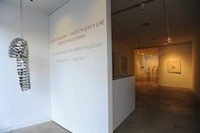By: Hyacinth Mascarenhas
In an increasingly globalized world and society, it’s hard to stand out especially in the art world. Brothers Projjal and Prajit Dutta sought to change that with the creation of the Aicon Gallery to create a platform for Indian and Pakistani artists to exhibit in the United States and Europe with the goal to encourage dialogue and cross-collaboration between South Asia and the west.
Projjal Dutta holds a MS in Architecture and Urbanism from MIT and an undergraduate degree from the School of Planning and Architecture, New Delhi. In addition to being a partner at the Aicon Gallery, he has also been a regular visiting faculty member at Columbia University and has taught also at NYU. We got a chance to speak with him.
Elan: You’re a partner at the Aicon Gallery, with locations across the globe. Tell us about it.
Projjal Dutta: The Aicon Gallery started in the Indian subcontinent which soon grew internationally with galleries in the Bay area, London and New York to give a platform for South Asian artists and contemporary South Asian art in the West. Although we are primarily in New York now, we still hope to be back in London at some point based on our clientele and the relationships we built there. Everything is in cold storage now, but we hope to go back soon.
Elan: Why was it important to have a gallery dedicated to promoting South Asian artists? How has the response been?
PD: Our earlier reasoning for the gallery came from the idea of South Asian versus non-South Asian art and the perception of South Asian art as a distinct regional activity and identity. We started off as a geographical niche but over time became a much larger production of art. The art may come from artists that don’t live in the subcontinent any more, or have Indian parents or lived there for some time and have a traditional connection to the region. We now highlight contemporary art from South Asian that is in essence stand alone art.
The response has been immediate where artists are thrilled and excited to be possibly featured in New York which is one of the capitals of the art world and a very desirable location for the art community.
Elan: What criteria do you have to identify the artists you’d like to promote?
PD: It’s more of a balance, if you will, where on the one hand you are being pitched to by artists as an idea platform. On the other hand, you are also pitching yourself to artists whose works are very desirable where you showcase what you can do for them and their careers.
Elan: What has been the galleries greatest success?
PD: One type of success is the creation of stars if you will where they were unknown before we started working with them and have gone on to achieve great success. For example, a couple of artists from Pakistan have really done well in great measure thanks to their association with us. After they have come on board and we started representing them, they have had museum shows gotten written up by magazines and newspapers which are, in the art world, are big achievements.
Another kind of success is introducing to the world artists that are already quite well known in South Asia like M. F. Husain, Tyeb Mehta, and Ram Kumar who are already very significant names in the art world but may be relatively unknown in the US. I think essentially if you are sort of a cultural bridge between art in the West and art in the East, a greater success is to be a strong and stable bridge to be around.
Art tends to be a very cyclical market when it comes down to the economy and many other galleries have actually shut down its operation where as we have actually maintained a steady programming and presence and introducing new audiences to new art. I think all of those have been, in my mind, our priceless piece of success.
Elan: What advice would you give to a youth South Asian artist?
PD: I think that artists struggle to find their language and their voice to make something distinct. It doesn’t happen overnight. Works start off by drawing an apple or a bottle or a nude figure where they can begin to find their voice. I think great artists are those who made a contribution to the visual vocabulary where there is a picture or style that wasn’t there before they came along.
Rather than worrying too much about telling and telling well, I would basically advise people to find that visual vocabulary and once they have it, the rest will follow.
Elan: What are some future plans to expand the Aicon Gallery?
PD: Right now we are quite programming quite aggressively in showing a lot of contemporary art from the South Asian region, especially from Pakistan. We started off in India and have grown outward from there. Now we are expanding in other nations to show contemporary art from the region and are even starting to show some works from Iraq so we are slowing broadening our focus as well.






























Comments